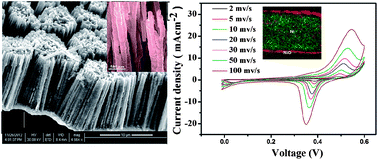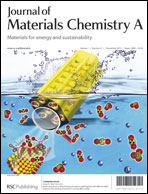Unique hydrogenated Ni/NiO core/shell 1D nano-heterostructures with superior electrochemical performance as supercapacitors†
Abstract
This study demonstrates a scheme to design and fabricate a novel 1D core/shell Ni/NiO nano-architecture electrode as a pseudocapacitor with significantly improved capacitive performance through hydrogenation. The specific capacitance of the as prepared 1D core/shell Ni/NiO nanoheterostructure (717 F g−1 at a scan rate of 2 mV s−1) is nearly 1635 F g−1 after the hydrogenation. The improved pseudocapacitive properties of hydrogenated Ni/NiO nano-heterostructures are attributed to the incorporation of the hydroxyl groups on the NiO surface due to hydrogenation, where the metallic Ni nanowire core of this unique 1D core/shell heterostructure serves as the efficient channel for the fast electron conduction to the current collector. The H–Ni/NiO nanoheterostructures exhibit good rate capability (retaining nearly 60% of their initial charge) and good long-term cycling stability with an excellent specific energy and power density of 49.35 W h kg−1 and 7.9 kW kg−1, respectively, at a current density of 15.1 A g−1. This study demonstrates that the H–Ni/NiO nano-heterostructure is very promising for next generation high-performance pseudocapacitors.


 Please wait while we load your content...
Please wait while we load your content...